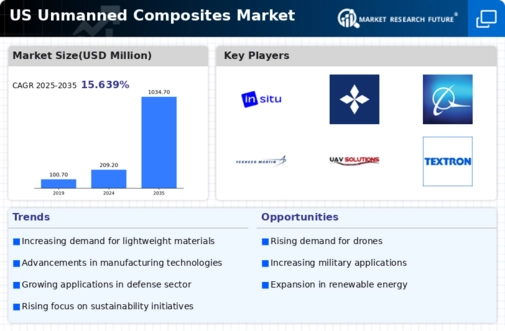The US Unmanned Composites Market is characterized by rapid advancements in technology and growing demand across various sectors, including defense, surveillance, and agricultural applications. As unmanned vehicles become increasingly sophisticated, the integration of composite materials enhances their performance, durability, and efficiency. This market is marked by intense competition among key players who are striving to innovate while meeting rising regulatory standards and customer expectations. Companies are focusing on developing lightweight, robust composite solutions that allow for longer flight times, improved payload capacities, and enhanced resistance to environmental factors.
Hence, the competitive landscape reflects a blend of research and development, strategic partnerships, and market positioning, with firms leveraging their technological prowess to maintain an edge over competitors.In the context of the US Unmanned Composites Market, Drone Aviation Holding is recognized for its specialized approach in developing advanced drone technologies. The company's strengths lie in its focus on integrating high-strength light-weight composites that maximize flight capabilities and operational efficiency. Through continuous investment in research and innovation, Drone Aviation Holding has carved a niche in delivering tailored solutions primarily to military and industrial clients.
Their efforts in enhancing the durability and functionality of unmanned aerial systems through composite materials have led to a solid market presence within the United States, where they actively contribute to the evolving landscape of drone applications. The company's unique value proposition lies in its ability to adapt quickly to changing market demands, making it a notable player within this competitive market.Insitu, with its strong reputation and extensive experience in the unmanned aircraft systems sector, stands out in the US Unmanned Composites Market by offering a range of innovative products designed for both military and commercial applications.
The company specializes in providing advanced reconnaissance and surveillance capabilities through its composite-based drones that prioritize durability and operational effectiveness. Insitu's strengths include its ability to deliver high-performance unmanned systems that integrate seamlessly with existing defense and intelligence platforms. The company has also ventured into strategic partnerships and acquisitions to enhance its product offerings and market reach. By continuously upgrading its technology and focusing on customer-centric solutions, Insitu has solidified its position in the US market, effectively addressing the needs of various industries while promoting advancements in unmanned composite technologies.





















Leave a Comment